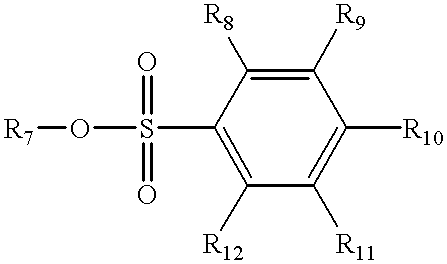Hydroxy-amino thermally cured undercoat for 193 nm lithography
a technology of hydroxyamino and hydroxyamino, which is applied in the field of hydroxyamino thermally cured undercoat for 193 nm lithography, can solve the problems of standing wave effect, too absorbent and insensitive resists used at the higher wavelengths, and reduce resolution
- Summary
- Abstract
- Description
- Claims
- Application Information
AI Technical Summary
Problems solved by technology
Method used
Image
Examples
example 1
Synthesis Procedure for Polymer 1
[0056] In a 100 ml three-necked round bottom flask equipped with a magnetic stir bar, addition funnel, condenser, and nitrogen inlet-outlet was added a mixture of 21.0 g of isobornyl methacrylate, 9.0 g of 4-hydroxystyrene 30 ml of tetrahydrofuran (THF) and 0.45 g of 2,2'-azobis(2-methylbutyronitrile). The mixture was heated to 65.degree. C. and stirred for 18 hours. The solution was precipitated by addition to 1 liter of hexanes, and the precipitate was filtered. The solid was dried for 1 hour under a water aspirator vacuum, subsequently dissolved in 80 ml of THF and reprecipitated in 1 liter of hexanes. The precipitate was filtered, and the solid dried at 4 mbar for 24 hours. The yield of polymer was between 77-80%. The above polymer was suspended in a mixture of 70 ml isoproponal, 50 ml THF and 29.5 ml of NH.sub.4OH under a nitrogen atmosphere. After refluxing overnight, the solution was cooled and precipitated by adding 1 liter of water. The susp...
example 2
Thermally Curable Polymer Composition using Polymer 1
[0057] A 15% by weight thermally curable polymer composition was formulated by combining 2.18 g of Polymer 1 from Example 1 above, 0.3 g of hexamethoxymethylmelamine and 0.8 g of cyclohexyl p-toluenesulfonate in 17 g of propylene glycol methyl ether acetate (PGMEA). The mixture was rolled overnight, and the undercoat solution was filtered twice through a 0.1 .mu.m Teflon filter.
example 3
Thermally Curable Polymer Composition using Polymer 2
[0058] A 15% by weight thermally curable polymer composition was formulated by combining 2.18 g of Polymer 2 obtained from Scientific Polymer Products, Inc. (60 mole % styrene and 40 mole % allyl alcohol), 0.3 g of hexamethoxymethylmelamine and 0.8 g of cyclohexyl p-toluenesulfonate in 17 g of propylene glycol methyl ether acetate (PGMEA). The mixture was rolled overnight, and the undercoat solution was filtered twice through a 0.1 .mu.m filter.
PUM
| Property | Measurement | Unit |
|---|---|---|
| wavelength | aaaaa | aaaaa |
| wavelength | aaaaa | aaaaa |
| temperatures | aaaaa | aaaaa |
Abstract
Description
Claims
Application Information
 Login to View More
Login to View More - R&D
- Intellectual Property
- Life Sciences
- Materials
- Tech Scout
- Unparalleled Data Quality
- Higher Quality Content
- 60% Fewer Hallucinations
Browse by: Latest US Patents, China's latest patents, Technical Efficacy Thesaurus, Application Domain, Technology Topic, Popular Technical Reports.
© 2025 PatSnap. All rights reserved.Legal|Privacy policy|Modern Slavery Act Transparency Statement|Sitemap|About US| Contact US: help@patsnap.com



